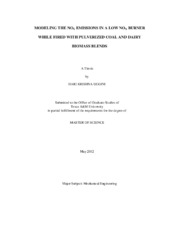| dc.description.abstract | New regulations like the Clean Air Interstate Rule (CAIR) will pose greater challenges for Coal fired power plants with regards to pollution reduction. These new regulations plan to impose stricter limits on NOX reduction. The current regulations by themselves already require cleanup technology; newer regulations will require development of new and economical technologies.
Using a blend of traditional fuels & biomass is a promising technology to reduce NOX emissions. Experiments conducted previously at the Coal and Biomass energy lab at Texas A&M reported that dairy biomass can be an effective Reburn fuel with NOX reduction of up to 95%; however little work has been done to model such a process with Feedlot Biomass as a blend with the main burner fuel. The present work concerns with development of a zero dimensional for a low NOx burner (LNB) model in order to predict NOX emissions while firing a blend of Coal and dairy biomass. Two models were developed. Model I assumes that the main burner fuel is completely oxidized to CO,CO2,H20 and fuel bound nitrogen is released as HCN, NH3, N2; these partially burnt product mixes with tertiary air, undergoes chemical reactions specified by kinetics and burns to complete combustion. Model II assumes that the main burner solid fuel along with primary and secondary air mixes gradually with recirculated gases, burn partially and the products from the main burner include partially burnt solid particles and fuel bound nitrogen partially converted to N2, HCN and NH3. These products mix gradually with tertiary air, undergo further oxidation-reduction reactions in order to complete the combustion. The results are based on model I. Results from the model were compared with experimental findings to validate it.
Results from the model recommend the following conditions for optimal reduction of NOx: Equivalence Ratio should be above 0.95; mixing time should be below 100ms. Based on Model I, results indicate that increasing percentage of dairy biomass in the blend increases the NOx formation due to the assumption that fuel N compounds ( HCN, NH3) do not undergo oxidation in the main burner zone. Thus it is suggested that model II must be adopted in the future work. | en |


